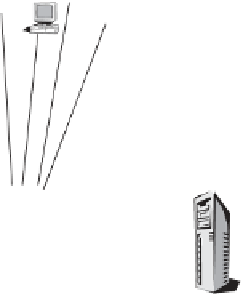Database Reference
In-Depth Information
Client Machines
Client Machines
Client Machines
Application
Server Machine
Database
Server Machine
Database
Server Machine
Database
Server Machine
Client/Server (2-Tier)
Intelligent Server (2-Tier)
Middleware (3-Tier)
Figure 18-13
Architectural options.
Synchronous and asynchronous replication
In our example of replication of the
EMPLOYEE relation, suppose some transaction at the London site wants to update
the copy of the relation at a certain time. How do we include the effects of the
update in all the copies? One method is for the transaction to update all copies of
the EMPLOYEE relation before it commits. This method is known as
synchronous
replication
. If there are too many copies spread around at different sites, then update
transactions will take a long time to synchronize all copies and commit.
Instead of updating all copies each time an update transaction executes, we can
wait to update the copies at a later time. This method is called
asynchronous repli-
cation
. At specific intervals, copies of modified relations are updated. Obviously,
anyone using a copy that has not yet been updated will not obtain the correct results.
Many commercial systems implement this method.
Architectural Options
Let us now turn our attention to options for the types of computing architectures
that are used for implementing distributed databases. You know that data are dis-
tributed among several sites of an organization. You have also learned the tech-
niques for dividing the database and distributing the fragments to the various sites.
You have examined the communications network options for linking the sites. What
types of architectures are suitable at the sites?
We will explore three common options. Figure 18-13 presents the three options.
Note how data access is provided in each option. We will now briefly describe the
three architectural options.
Client/Server Architecture (Two Tier)
As an information technology profes-
sional, you are familiar with client/server systems. Let us examine how this archi-
tecture works for distributed database systems in very simple terms. At each site
















Search WWH ::

Custom Search